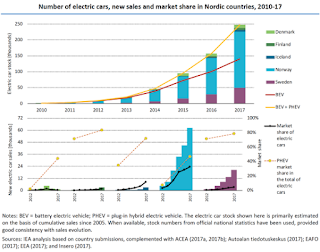Further, the number of electric vehicles (EVs) in the Nordic region is projected to reach 4 million cars by 2030—more than 15 times the number currently in circulation, according to the International Energy Agency’s Nordic EV Outlook 2018 (NEVO 2018). The report outlines the key factors contributing to successful developments and identifies key lessons to be learned, providing insights for countries currently developing their electric mobility strategies.
The Nordic countries represent the third-largest electric-car market by sales, after China and the United States. Norway leads the way with a 39% market share of electric car sales—the highest globally. Sweden has more than 49,000 electric cars in circulation and accounts for 20% of the total Nordic stock.
This remarkable growth has been driven by strong policy support and ambitious decarbonization goals, putting the region at the forefront of the transition to electric mobility. In this context, IEA intends for Nordic EV Outlook 2018 to provide a useful benchmark and to highlight a series of best practices—and hurdles to avoid—for countries around the world.
 Policy support has significantly influenced electric-car adoption across these countries, the main driver being measures that reduce the purchase price of electric vehicles. Other important measures that have proven successful in Nordic countries include a cut to circulation taxes, or local incentives such as waivers or partial exemptions on road-use charges, free parking or allowing access to bus lanes.
Policy support has significantly influenced electric-car adoption across these countries, the main driver being measures that reduce the purchase price of electric vehicles. Other important measures that have proven successful in Nordic countries include a cut to circulation taxes, or local incentives such as waivers or partial exemptions on road-use charges, free parking or allowing access to bus lanes.In addition support for the deployment of infrastructure has supported EV growth, in particular policy support for charging infrastructure. Though around 80% of EV charging takes place at home, wide availability of publicly accessible chargers can encourage consumers to consider the purchase of an electric car while also enabling longer distance trips.
Read more at IEA Report Draws Lessons from Rapid Uptake of EVs in Nordic Countries

No comments:
Post a Comment